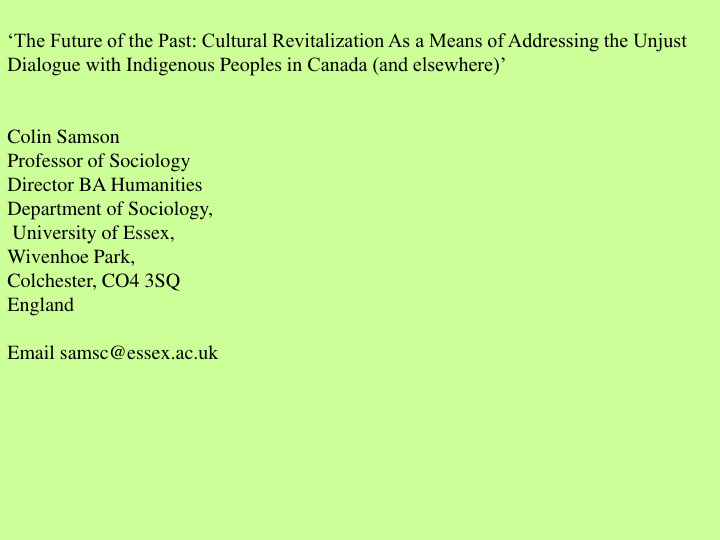



‘The Future of the Past: Cultural Revitalization As a Means of Addressing the Unjust Dialogue with Indigenous Peoples in Canada (and elsewhere)’ Colin Samson Professor of Sociology Director BA Humanities Department of Sociology, University of Essex, Wivenhoe Park, Colchester, CO4 3SQ England Email samsc@essex.ac.uk
What’s the future of our past? Note in San Xavier del Bac Museum, San Xavier O’odham Reservation, 2010 They have assumed the names and gestures of their enemies, but have held on to , their own, secret souls; and in this there is resistance and an overcoming, a long outwaiting. N. Scott Momaday (1968), House Made of Dawn , New York: Harper and Row, 58.
DIMENSIONS OF ENFORCED SOCIAL CHANGE OCCURRING TO INDIGENOUS PEOPLES 1. ECONOMIC CHANGE - undermining of indigenous economies, largely from fairly independent and self-sufficient communitarian economies to welfare dependency and increasingly, in Canada and elsewhere, towards sharper and more highly differentiated social and economic divisions within indigenous communities. From shared ownership of land to state-induced decollectivistaion and privatization. 2. ECOLOGICAL CHANGE - from the idea of nature as something not apart from the person/group to the idea of nature as a commodity, external to us, something to be dominated, and from a relatively light environmental touch to an extremely heavy one with many indigenous territories used or earmarked for megaprojects or ‘national sacrifice areas’ 3. FOOD AND NUTRITION – a dramatic ‘nutrition transition’ (Barry Popkin) from wild food diets – high in omega 3s, protein, and antioxidants - to junk foods high in carbohydrates and saturated fats and having less protein and essential minerals. Accompanying this is a shift towards long term chronic diseases in proportions that far outstrip those of other state populations, and including epidemics of diabetes, heart conditions, and foetal alcohol syndrome. Externally induced changes in economies and ecologies has produced a shift away from local food procurement entailing vigorous physical activity including walking, pulling, carrying, building and making things to sedentary lives as wage labourers or welfare recipients.
Figure 1. Leakages from the local economy and culture Money for goods and services Money for salaries Large leakage of money and raw materials
Figure 2. Plugging the leaks in the local economy Money for goods and services Money for salaries 6. Attract New Money and Human Resources (eg tourism, grants, skills) 1. Use Renewable and Local Resources (eg sustainable agriculture, green energy, business buy local, local food systems 2. Recycle Finance and Materials (waste minimisation, credit unions and LETS, materials recycling, composting) 3. Add Value to Local Produce ( eg farmers’ markets, green tourism, labelling, local processing and manufacture) 4. Connect up Local People and Organisations (relations of trust, horizontal and vertical links, community participation) 5. Build Human Capital Skills and Knowledge (formal and informal training, extension programmes, farmers’ groups) Leakage reduced
Kamestastin Lake, Northern Labrador Camp established by Tshikapisk Foundation
Tshikapisk Foundation sponsored trip with Innu youth from Orma lake to Kapaumiskat
Examples of Renewable Resource Local Economies: 1. Tshikapisk Foundation – run by Innu hunting families in Labrador. 2. Co-operatives that market and sell Inuit crafts, carvings, and other products and also Inuit run fishing lodges and hotels run on a co-operative basis. This also includes the Hunter Support Program in Nunavik which pays hunters to hunt and distribute meat and fish to communities 3. Restoration of communal agriculture among Pueblos and O’odham peoples in the US Southwest. 4. Restoration of bison in the US Great Plains via the Inter Tribal Buffalo Council 5. Dam Removal on the Klamath River and reintroduction of communal salmon fishing and distribution (Karuk and Yurok)
Recommend
More recommend